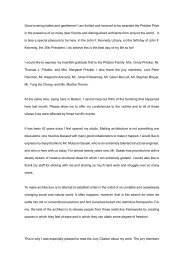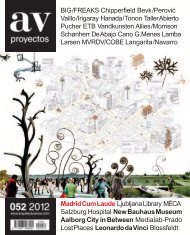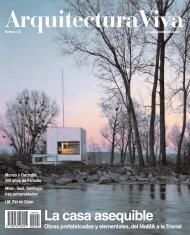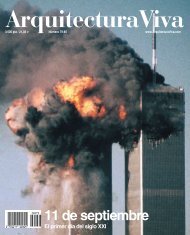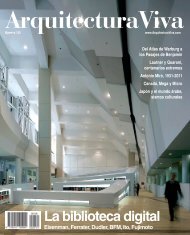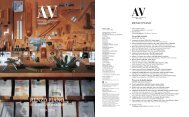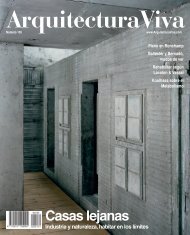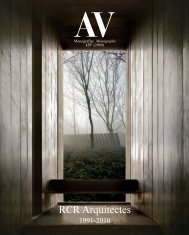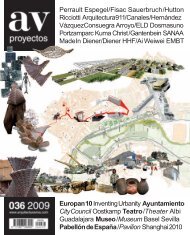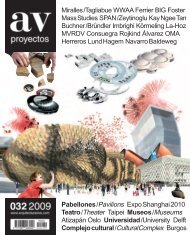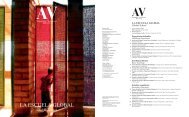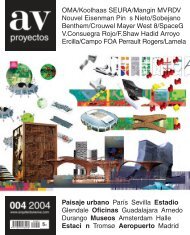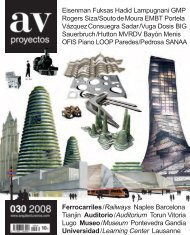SOUTO DE MOURA - Arquitectura Viva
SOUTO DE MOURA - Arquitectura Viva
SOUTO DE MOURA - Arquitectura Viva
You also want an ePaper? Increase the reach of your titles
YUMPU automatically turns print PDFs into web optimized ePapers that Google loves.
Melancolía y metafísica<br />
Eduardo Souto de Moura es autor de obra escueta, limitada en el número y lacónica<br />
en la cualidad. El conjunto que aquí se presenta, más obras esenciales que<br />
obras escogidas, recorre su trayecto completo, desde su esforzado aprendizaje<br />
con Álvaro Siza Vieira hasta la consagración mediática del premio Pritzker: un<br />
viaje testarudo de las raíces que se hunden en el humus local a las ramas que se<br />
extienden por el firmamento global. Interpretando su itinerario con los jalones de<br />
los proyectos, esta publicación no es tanto una biografía (profesional) autorizada<br />
como una aproximación a la autobiografía científica que, evocando a su admirado<br />
Aldo Rossi, algún día Souto deberá ofrecernos.<br />
Teñida de melancolía desde su primera posta —ese mercado de Braga al que el<br />
arquitecto regresa para enmarcar con música y danza una estoa floral que exhibe<br />
su demolición incompleta como un cuarto orden—, la ruta persigue un empeño de<br />
depuración metafísica que se extiende hasta los últimos proyectos, lejanos ya de<br />
la saudade de Oporto pero empeñados todos en un ensimismamiento solipsista,<br />
como corresponde a arquitecturas que extraen su naturaleza más de su obstinada<br />
identidad que del contexto azaroso. Este último Souto se va por las ramas, pero<br />
cada brote suspendido en el aire del mundo sigue alimentado por la savia que<br />
mana desde su cepellón de arraigo y pertenencia.<br />
La robustez de la obra se afirma en sus orígenes, por más que estos no se hallen<br />
tanto en la canónica sucesión Távora-Siza-Souto que en su momento se acuñó<br />
como Escuela de Oporto, sino en la secuencia Mies-Rossi-Souto: una anatomía<br />
de las influencias de mayor fertilidad interpretativa, aunque no refleja de la<br />
misma forma los vínculos vitales. El rigor geométrico, la disciplina del detalle y<br />
la abstracción despojada de Mies van der Rohe se matizan en Souto con la pasión<br />
vernácula, la nostalgia formal y la figuración esencial de Rossi, un maestro cuya<br />
triple fidelidad a Mies, Loos y Tessenow marcó a una generación europea, que<br />
halló en el milanés su referente artístico e intelectual.<br />
De ese momento y esas inquietudes son también partícipes arquitectos como<br />
Herzog y de Meuron o Chipperfield, y no es casual que el portugués haya transitado<br />
desde las exactas casas de piedra y vidrio de sus inicios —tan densamente materiales<br />
como las primeras de los suizos— hasta el monumental bodegón metafísico<br />
de Santa Coloma, que resulta inevitable comparar con los prismas impávidos del<br />
británico en Barcelona. Acaso esta compañía sea más apropiada para Souto que<br />
la sugerida por los que lo asocian a Murcutt o Zumthor en reductos de excelencia<br />
local; si así fuese, la creciente internacionalización de su trabajo no arrojaría la<br />
amenaza de la sombra sobre una obra luminosa.<br />
Luis Fernández-Galiano<br />
Eduardo Souto de Moura is the author of a succinct<br />
oeuvre, limited in number and laconic in quality. The<br />
collection presented here, which can be described as<br />
essential rather than selected works, covers a thirtyyear-long<br />
career, from his demanding training with<br />
Álvaro Siza Vieira to the worldwide media recognition<br />
that comes with the Pritzer Prize: a tenacious journey<br />
from the roots that go deep into the local humus to<br />
the branches that spread across the global skies.<br />
Interpreting his itinerary with the milestones of twenty<br />
projects, this publication is in the end not so much<br />
an authorized (professional) biography but rather a<br />
tentative approach to the scientific autobiography<br />
that, evoking his admired Aldo Rossi, some day Souto<br />
will have to offer us.<br />
Tinged with melancholy from his first stop on the<br />
road – the Carandá Market in Braga, to which the<br />
architect returned twenty years later to frame with<br />
music and dance a floral stoa which displays its<br />
incomplete demolition as a fourth architectural order –,<br />
the path pursues a search for metaphysical purity that<br />
extends to the latest projects, all of them far from the<br />
saudade of Porto but nonetheless immersed in a sort of<br />
solipsist self-withdrawal, as perhaps befits architectures<br />
that extract their ultimate nature from their stubborn<br />
identity rather than from different, haphazard contexts.<br />
This recent Souto may indeed be seen as beating around<br />
the bush, but each sprout suspended in the air of the<br />
world keeps feeding on the sap that flows from its root<br />
of stern belonging.<br />
The consistency of his oeuvre is reasserted in its<br />
origins, even though these are not really to be found in<br />
the canonical succession Távora-Siza-Souto that was<br />
labelled as the School of Porto, but rather in the Mies-<br />
Rossi-Souto sequence: an anatomy of influences with a<br />
greater fertility for interpretation, although it does not<br />
reflect the vital connections with the same precision.<br />
The geometric rigor, the discipline of detail and the<br />
bare abstraction of Mies van der Rohe are nuanced in<br />
Souto with the vernacular passion, the formal nostalgia<br />
and the essential figuration of Rossi, a master whose<br />
three-thronged fidelity to Mies, Loos and Tessenow<br />
marked a whole European generation, which found in<br />
the Milanese architect its most significant artistic and<br />
intellectual referent.<br />
That moment and those concerns were also those of<br />
architects like Herzog & de Meuron or Chipperfield,<br />
and it is no coincidence that the Portuguese has<br />
moved from the exact houses of stone and glass of his<br />
beginnings – so densely material as the first ones of<br />
the Swiss – to the monumental metaphysical still life<br />
of his residential complex in Santa Coloma, which<br />
one inevitably compares with the impassive prisms<br />
of the British in Barcelona’s City of Justice. Perhaps<br />
this company is more appropriate for Souto than the<br />
one suggested by those who relate him to Murcutt or<br />
Zumthor in precincts of local excellence; if this were so,<br />
the increasing internationalization of his work would<br />
not cast the threat of a shadow upon a luminous oeuvre.<br />
AV Monographs 151 2011 3



